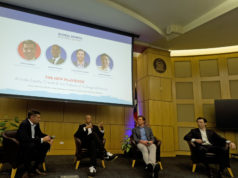Dear Lord, holy crap, and every other verbal ejaculation you can think of. The college football world and a good portion of the world beyond is reeling from Deadspin’s bombshell about Manti Te’o, the linebacker whose play keyed Notre Dame’s magical football season. As was widely reported in the sporting press, he played through the heartache of losing Lennay Kekua, his girlfriend who passed away this past September after a bout with leukemia, having previously survived a life-threatening car accident. As Deadspin found out, there was a small hole in this tragic story: Lennay Kekua never existed.
Remember when college football scandals were about recruiting violations and illegal cash payments? Between this and the extended ugliness at Penn State this time last year, the bar has been raised so high that we can’t even see it any more. As of this posting, we don’t know exactly what role Te’o (a Heisman Trophy finalist and a projected high first-round pick in the upcoming NFL draft) played. Was he a victim of a friend’s sadistic prank, or a co-perpetrator of a monstrous ploy for publicity? Or did something else happen? I can think of a couple of scenarios, but I won’t air them until we know more.
That Te’o’s story went unchecked for this long demonstrates the herd mentality of reporters. SB Nation compiles a list of media organizations that never checked out the story, placing itself at the top. Meanwhile, ESPN’s Gene Wojciechowski admits that he should have red-flagged the story when he couldn’t find records of the accident, but that Te’o told him not to contact the family. Looks like he was done in by politeness there. Josh Levin at Slate argues that the linebacker’s good guy image discouraged journalists from doing their jobs, but Sports Illustrated’s Michael Rosenberg makes a salient point when he points out that this scenario is so far removed from previous experience that it simply wouldn’t occur to many reporters. Just because you can’t get hold of someone doesn’t mean they don’t exist. Now, of course, journalists of every stripe will remember this example when they assume things about people they can’t track somebody down.
I’m reminded of a sports hoax that broke a few years ago: the saga of Masal Bugduv. The 16-year-old soccer phenom from the tiny nation of Moldova was supposedly being hotly pursued by a number of big teams in 2009, and he was listed as a promising talent in the Times of London, as well as other reputable media outlets. You guessed it: The kid didn’t exist. He was created by an Irish fan who wanted to demonstrate the inanity of soccer transfer speculation and the laxity of British press regulations that allowed such a hoax to flourish. Of course, that fabrication was driven by a much more benign agenda than the Kekua story.
The lesson here, kids, is simple: Don’t impersonate other people online. Not only is it a terrible thing to do, but you’ll eventually be caught. That’s exactly what happened in Catfish, a movie referenced by Notre Dame athletic director Jack Swarbrick when he defended his player, and which I blogged about at the time of its release. Fittingly enough, the producers of that film and its TV spinoff had already been contacted by people connected to this case. I’ve said it before on this site: The same technology that allows you to create a whole online persona allows somebody else to unravel it. It may take a few months if they’re a sportswriter, but it’ll happen.
One last thing, the whole story has already inspired a Tumblr meme. Send in pictures of your imaginary girlfriend!













Any advice, Jeff, on how I can get me a fake Twitter girlfriend. I think that would be the ideal option for me (and a lot of guys I know).
No mention of Obama’s “composite” (fake) girlfriend?